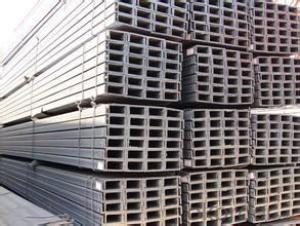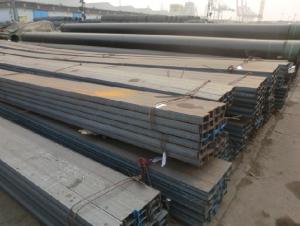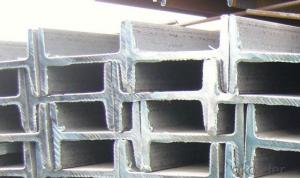Hot Rolled Mild Carbon Structural Steel U-Channel
- Loading Port:
- Qingdao
- Payment Terms:
- TT or LC
- Min Order Qty:
- 2000 PCS
- Supply Capability:
- 40000 PCS/month
OKorder Service Pledge
OKorder Financial Service
You Might Also Like
Hot Rolled Mild Carbon Structural Steel U-Channel
OKorder is offering high quality Hot Rolled Mild Carbon Structural Steel U-Channels at great prices with worldwide shipping. Our supplier is a world-class manufacturer of steel, with our products utilized the world over. OKorder annually supplies products to European, North American and Asian markets. We provide quotations within 24 hours of receiving an inquiry and guarantee competitive prices.
Product Applications:
Hot Rolled Mild Carbon Structural Steel U-Channels are ideal for structural applications and general fabricating.
Product Advantages:
OKorder's Steel Channels are durable, strong, and resists corrosion.
Main Product Features:
· Premium quality
· Prompt delivery & seaworthy packing (7-10 days after receiving deposit)
· Corrosion resistance
· Can be recycled and reused
· Mill test certification
· Professional Service
· Competitive pricing
Product Specifications:
Base Model
Grade: Q195 / Q235 / Q215 / Q345 / SS400 / S235JR, A36, SS400, SS540, ASTM A36
Height: 50 – 400mm
Thickness: 4.5 – 14.5mm
Length: As per customer request
Max Dimensions: 50*37*4.5mm – 400*104*14.5mm
Surface: Painted, galvanized, as per customer request
Punch: Punched as per customer request
Light Model
Grade: Q195 / Q235 / Q215 / Q345 / SS400 / S235JR, A36, SS400, SS540, ASTM A36
Height: 50 – 400mm
Thickness: 4.4 – 8.0mm
Length: As per customer request
Max Dimensions: 50*32*4.4mm – 400*115*8.0mm
Surface: Painted, galvanized, as per customer request
Punch: Punched as per customer request
FAQ:
Q1: Why buy Materials & Equipment from OKorder.com?
A1: All products offered byOKorder.com are carefully selected from China's most reliable manufacturing enterprises. Through its ISO certifications, OKorder.com adheres to the highest standards and a commitment to supply chain safety and customer satisfaction.
Q2: How do we guarantee the quality of our products?
A2: We have established an advanced quality management system which conducts strict quality tests at every step, from raw materials to the final product. At the same time, we provide extensive follow-up service assurances as required.
Q3: How soon can we receive the product after purchase?
A3: Within three days of placing an order, we will begin production. The specific shipping date is dependent upon international and government factors, but is typically 7 to 10 workdays.
Q4: What makes stainless steel stainless?
A4: Stainless steel must contain at least 10.5 % chromium. It is this element that reacts with the oxygen in the air to form a complex chrome-oxide surface layer that is invisible but strong enough to prevent further oxygen from "staining" (rusting) the surface. Higher levels of chromium and the addition of other alloying elements such as nickel and molybdenum enhance this surface layer and improve the corrosion resistance of the stainless material.
Q5: Can stainless steel rust?
A5: Stainless does not "rust" as you think of regular steel rusting with a red oxide on the surface that flakes off. If you see red rust it is probably due to some iron particles that have contaminated the surface of the stainless steel and it is these iron particles that are rusting. Look at the source of the rusting and see if you can remove it from the surface.
Images:


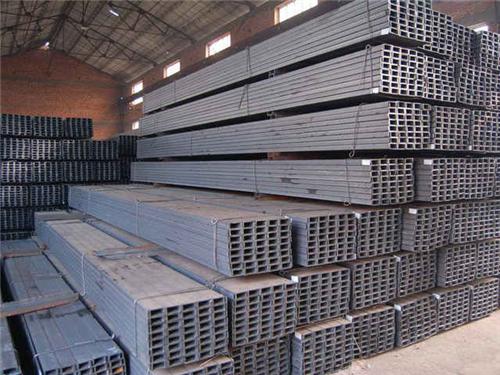
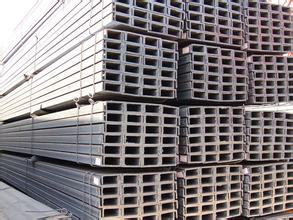
- Q:Can steel I-beams be used for flood-resistant structures?
- Yes, steel I-beams can be used for flood-resistant structures. Steel is a durable and strong material that can withstand the forces of floodwaters. Additionally, the I-beam shape provides structural stability and reduces the risk of collapse during a flood event. However, other factors such as proper design, construction techniques, and flood mitigation measures should also be considered for effective flood resistance.
- Q:Can steel I-beams be used for industrial machinery?
- Yes, steel I-beams can be used for industrial machinery. Steel I-beams are commonly used in construction and engineering projects due to their strength, durability, and load-bearing capabilities. They can be effectively utilized in the construction of heavy-duty industrial machinery frames and supports, providing stability and structural integrity.
- Q:Can steel I-beams be used in both residential and commercial construction?
- Steel I-beams are suitable for use in both residential and commercial construction. They are a popular choice in the construction industry due to their strength, durability, and versatility. In residential construction, steel I-beams can be utilized as load-bearing components to support the weight of the structure. This is especially beneficial in the construction of larger homes or multi-story buildings. They are commonly employed to create open floor plans, enabling wider spans and fewer support columns. This allows for greater design flexibility. In commercial construction, steel I-beams are extensively utilized in the construction of large-scale buildings such as office complexes, warehouses, and shopping centers. They provide superior structural integrity, allowing for taller buildings and larger open spaces. Additionally, steel I-beams possess fire-resistant properties, making them a preferred choice for both residential and commercial construction projects due to their safety features. Overall, steel I-beams are a reliable and versatile option for construction projects in both residential and commercial areas.
- Q:How about 5 tons of crane rail fixed on I-steel
- First, the pressure plate shall be punched on i-beam. Second the guide rail is screwed with a hook screw and third is welded directly with the welding pressure plate
- Q:What are the different methods of protecting steel I-beams from corrosion?
- There are several methods available for protecting steel I-beams from corrosion. The choice of method depends on factors such as the environment in which the beams will be placed, the expected level of corrosion, and the desired lifespan of the beams. Here are some common methods: 1. Galvanization: This is a popular method where the steel beams are coated with a layer of zinc. The zinc acts as a sacrificial anode, protecting the underlying steel from corrosion. Galvanized steel beams are highly resistant to rust and can withstand harsh environments, making them suitable for outdoor applications. 2. Protective coatings: Another effective method is applying protective coatings on the surface of the steel beams. These coatings can be epoxy-based, polyurethane-based, or other specialized coatings designed to provide a barrier against moisture and corrosive substances. The thickness and type of coating depend on the specific requirements of the project. 3. Cathodic protection: This method involves the use of a sacrificial anode or an impressed current system to protect the steel beams from corrosion. In sacrificial anode systems, a more reactive metal, such as zinc or aluminum, is connected to the steel beams. The anode corrodes instead of the steel beams, thereby protecting them. Impressed current systems involve the use of an external power source to create an electric current that counteracts the corrosion process. 4. Stainless steel construction: Using stainless steel for the I-beams themselves is another effective way to protect against corrosion. Stainless steel contains chromium, which provides a passive protective layer that prevents rust formation. However, stainless steel is generally more expensive than regular steel, so cost considerations may influence its use. 5. Proper maintenance: Regular inspection, cleaning, and maintenance of steel I-beams can significantly extend their lifespan. This involves removing any accumulated dirt, debris, or corrosive substances, and promptly repairing any damaged or deteriorated protective coatings. Regular maintenance can help identify potential corrosion issues early on and prevent further damage. It is important to consider the specific requirements and constraints of each project before selecting a corrosion protection method for steel I-beams. Consulting with experts and conducting a thorough evaluation of the environmental conditions and expected lifespan of the beams will help determine the most suitable method for protecting against corrosion.
- Q:How do steel I-beams handle vibrations from nearby airports or helipads?
- Steel I-beams are incredibly strong and rigid, making them highly effective in handling vibrations from nearby airports or helipads. The structural integrity and stiffness of steel I-beams allow them to absorb and dissipate vibrations efficiently, minimizing the impact on the surrounding structures. Additionally, their dense mass helps to dampen vibrations, ensuring a stable and secure environment.
- Q:How do steel I-beams perform in terms of vibration control?
- Steel I-beams are widely recognized for their exceptional strength and load-bearing capabilities. However, when it comes to vibration control, their performance may vary depending on several factors. Firstly, steel I-beams have a natural frequency at which they tend to vibrate. This natural frequency is determined by their dimensions, material properties, and overall structural configuration. If the excitation frequency of the vibration matches the natural frequency of the beam, resonance can occur, leading to increased vibrations and potentially compromising the structural integrity. To mitigate vibrations in steel I-beams, several strategies can be employed. One common approach is to increase the stiffness of the beam by adding additional steel plates or braces. This increases the natural frequency of the beam, making it less susceptible to resonance with external vibrations. Additionally, damping systems can be incorporated into the design of steel I-beams to dissipate energy and reduce vibrations. These systems typically consist of damping materials, such as viscoelastic polymers or rubber pads, that absorb and dissipate vibrational energy. It is worth noting that the performance of steel I-beams in terms of vibration control can also be influenced by the surrounding structural elements and the overall design of the building or structure. For example, the presence of other damping elements, such as tuned mass dampers or base isolators, can further enhance the vibration control capabilities of steel I-beams. In summary, steel I-beams have inherent natural frequencies that can affect their performance in terms of vibration control. By increasing stiffness and incorporating damping systems, the vibrations can be mitigated and the overall structural integrity can be maintained. However, it is crucial to consider the specific design requirements and surrounding structural elements to optimize the vibration control performance of steel I-beams.
- Q:Can steel I-beams be used in earthquake-prone areas?
- In earthquake-prone areas, steel I-beams are indeed a viable option. In fact, steel is often the preferred choice for structural elements in buildings designed to withstand earthquakes. There are several advantages to using steel I-beams in these areas. Firstly, steel is renowned for its strength and ductility, enabling it to endure the forces generated by earthquakes. Secondly, the shape of I-beams offers exceptional structural integrity, evenly distributing the load and minimizing the risk of collapse. Additionally, steel I-beams possess the ability to flex and absorb energy during seismic activity, thereby dissipating the forces and safeguarding the overall structural integrity of the building. To ensure optimal performance in earthquake-prone areas, it is crucial to consider proper engineering, design, and the implementation of adequate connections and reinforcements for steel I-beams.
- Q:What are the common finishes or coatings applied to steel I-beams?
- The common finishes or coatings applied to steel I-beams include galvanization, painting, and powder coating. Galvanization involves coating the steel with a layer of zinc to protect it from corrosion. Painting is another common finish, where a layer of paint is applied to enhance the appearance and provide additional protection. Powder coating is another option, where a dry powder is sprayed onto the steel and then cured with heat to create a durable and attractive finish.
- Q:Are steel I-beams affected by vibrations?
- Yes, steel I-beams can be affected by vibrations. Vibrations can cause the beams to resonate, leading to fatigue and potential failure over time. It is important to consider the frequency, amplitude, and duration of vibrations when designing structures with steel I-beams to ensure their stability and durability.
1. Manufacturer Overview |
|
|---|---|
| Location | |
| Year Established | |
| Annual Output Value | |
| Main Markets | |
| Company Certifications | |
2. Manufacturer Certificates |
|
|---|---|
| a) Certification Name | |
| Range | |
| Reference | |
| Validity Period | |
3. Manufacturer Capability |
|
|---|---|
| a)Trade Capacity | |
| Nearest Port | |
| Export Percentage | |
| No.of Employees in Trade Department | |
| Language Spoken: | |
| b)Factory Information | |
| Factory Size: | |
| No. of Production Lines | |
| Contract Manufacturing | |
| Product Price Range | |
Send your message to us
Hot Rolled Mild Carbon Structural Steel U-Channel
- Loading Port:
- Qingdao
- Payment Terms:
- TT or LC
- Min Order Qty:
- 2000 PCS
- Supply Capability:
- 40000 PCS/month
OKorder Service Pledge
OKorder Financial Service
Similar products
New products
Hot products
Related keywords
